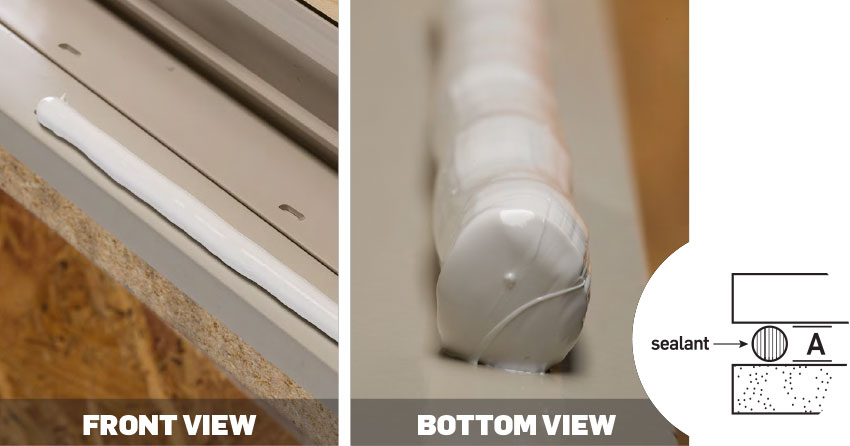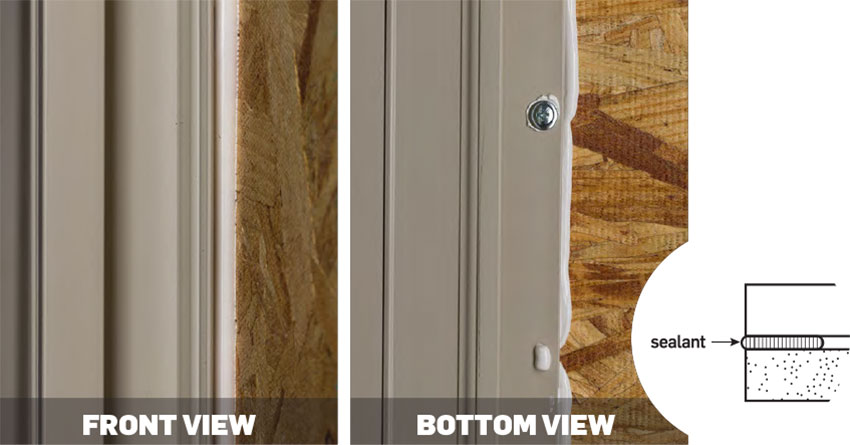A New Era of Exterior Sealants
Bedding Joint
A bedding joint is a type of sealing joint that is parallel between two planes to bond and seal both surfaces together. Dimension A must be a ⅜ inch rounded sealant bead. Apply the sealant to the substrate and minimize pressure when applying the sealant to maintain a rounded bead. Another acceptable way to apply the bedding bead is by compressing sealant between both substrates. Avoid excessive substrate movement after compression. Movement of the substrate can smear the sealant and break down the sealant’s capacity to maintain a gasket seal. This leaves an insufficient amount of sealant to accommodate joint movement and allows air and moisture to penetrate the gap.
When selecting a sealant to be used in the joints listed above, it’s important to check the ASTM C920 specifications and classifications to see which sealants best fit your application. Make sure the sealant will adhere to all of the types of building materials around the gap. Also ensure that the classification allows for the proper expansion and compression required to fill the space and the joint type. When the appropriate sealant has been applied, all that’s left is to let the sealant cure and dry. Check for any shrinkage or cracking while the sealant cures.

A bedding joint is a type of sealant joint that is parallel between two planes to bond and seal both surfaces together. This is an example of a bedding joint sealed using best practices.

This is an example of a bedding joint sealed using best practices.

This is an example of an unreliable bedding bead because the substrate movement will smear the sealant, breaking down the capacity to maintain the gasket seal.
Conclusion
Sealing the building envelope with high-quality sealants can not only provide a more comfortable environment inside, but it can also make the building more energy efficient and the structure more stable. Thanks to industry standards and technological advances, quality sealants are not only available on the market but easy to identify and apply. Throughout this course, you’ve learned how to identify gaps in the building envelope, select the proper sealant based on its materials, classifications, usage, and properties, and effectively apply it to protect the building from the elements.
Resources
Article:
Majka, Paul. “A Systems Approach to the Building Envelope.” Builder and Developer. Web. 10 Nov. 2017.
U.S. Department of Energy – Codes:
Air Leakage Guide. Building Technologies Program. U.S. Department of Energy. Sept. 2011. Web. 10 Nov. 2017.
Case study:
“SoCal weather: Mother Nature’s velvet fist.” OSI. Web. 10 Nov. 2017.
Software tools for windows and building envelope:
“Windows and Building Envelope.” U.S. Department of Energy. Web. 10 Nov. 2017.
Identifying and air sealing the building envelope PPT:
“Identifying and Air Sealing the Building Envelope.” U.S. Department of Energy. July 2012. Web. 10 Nov. 2017.
Andrew A. Hunt is vice president of Confluence Communications and has been a writer and consultant in the green building and building science industry for over a decade. He has authored more than 100 continuing education and technical publications as part of a nationwide practice. confluencec.com

|
Henkel’s Adhesive Technologies group is a global leader in adhesives, sealants, and functional coatings with brands including Loctite® and OSI™. OSI™ stands for innovation, not only in products but in the total process that ensures that building professionals have the right products, the right application, and the right methods to complete their jobs. www.ositough.com |








